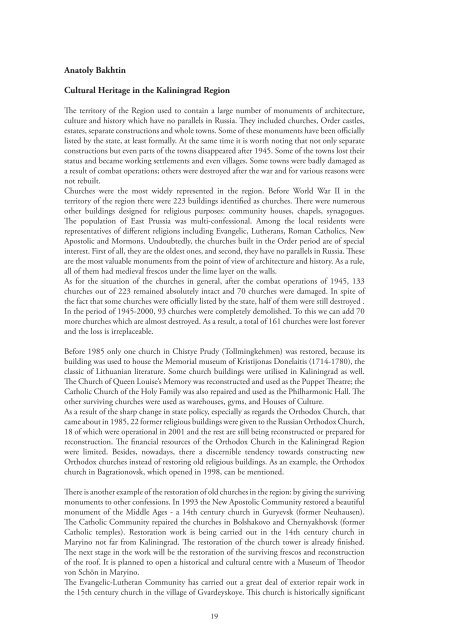BALTIC MEETINGS - Baltic Writers Council
BALTIC MEETINGS - Baltic Writers Council
BALTIC MEETINGS - Baltic Writers Council
Create successful ePaper yourself
Turn your PDF publications into a flip-book with our unique Google optimized e-Paper software.
Anatoly Bakhtin<br />
Cultural Heritage in the Kaliningrad Region<br />
e territory of the Region used to contain a large number of monuments of architecture,<br />
culture and history which have no parallels in Russia. ey included churches, Order castles,<br />
estates, separate constructions and whole towns. Some of these monuments have been officially<br />
listed by the state, at least formally. At the same time it is worth noting that not only separate<br />
constructions but even parts of the towns disappeared after 1945. Some of the towns lost their<br />
status and became working settlements and even villages. Some towns were badly damaged as<br />
a result of combat operations; others were destroyed after the war and for various reasons were<br />
not rebuilt.<br />
Churches were the most widely represented in the region. Before World War II in the<br />
territory of the region there were 223 buildings identified as churches. ere were numerous<br />
other buildings designed for religious purposes: community houses, chapels, synagogues.<br />
e population of East Prussia was multi-confessional. Among the local residents were<br />
representatives of different religions including Evangelic, Lutherans, Roman Catholics, New<br />
Apostolic and Mormons. Undoubtedly, the churches built in the Order period are of special<br />
interest. First of all, they are the oldest ones, and second, they have no parallels in Russia. ese<br />
are the most valuable monuments from the point of view of architecture and history. As a rule,<br />
all of them had medieval frescos under the lime layer on the walls.<br />
As for the situation of the churches in general, after the combat operations of 1945, 133<br />
churches out of 223 remained absolutely intact and 70 churches were damaged. In spite of<br />
the fact that some churches were officially listed by the state, half of them were still destroyed .<br />
In the period of 1945-2000, 93 churches were completely demolished. To this we can add 70<br />
more churches which are almost destroyed. As a result, a total of 161 churches were lost forever<br />
and the loss is irreplaceable.<br />
Before 1985 only one church in Chistye Prudy (Tollmingkehmen) was restored, because its<br />
building was used to house the Memorial museum of Kristijonas Donelaitis (1714-1780), the<br />
classic of Lithuanian literature. Some church buildings were utilised in Kaliningrad as well.<br />
e Church of Queen Louise’s Memory was reconstructed and used as the Puppet eatre; the<br />
Catholic Church of the Holy Family was also repaired and used as the Philharmonic Hall. e<br />
other surviving churches were used as warehouses, gyms, and Houses of Culture.<br />
As a result of the sharp change in state policy, especially as regards the Orthodox Church, that<br />
came about in 1985, 22 former religious buildings were given to the Russian Orthodox Church,<br />
18 of which were operational in 2001 and the rest are still being reconstructed or prepared for<br />
reconstruction. e financial resources of the Orthodox Church in the Kaliningrad Region<br />
were limited. Besides, nowadays, there a discernible tendency towards constructing new<br />
Orthodox churches instead of restoring old religious buildings. As an example, the Orthodox<br />
church in Bagrationovsk, which opened in 1998, can be mentioned.<br />
ere is another example of the restoration of old churches in the region: by giving the surviving<br />
monuments to other confessions. In 1993 the New Apostolic Community restored a beautiful<br />
monument of the Middle Ages - a 14th century church in Guryevsk (former Neuhausen).<br />
e Catholic Community repaired the churches in Bolshakovo and Chernyakhovsk (former<br />
Catholic temples). Restoration work is being carried out in the 14th century church in<br />
Maryino not far from Kaliningrad. e restoration of the church tower is already finished.<br />
e next stage in the work will be the restoration of the surviving frescos and reconstruction<br />
of the roof. It is planned to open a historical and cultural centre with a Museum of eodor<br />
von Schön in Maryino.<br />
e Evangelic-Lutheran Community has carried out a great deal of exterior repair work in<br />
the 15th century church in the village of Gvardeyskoye. is church is historically significant<br />
19


